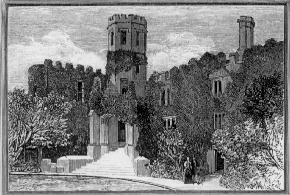AwayMave Home Page | IEPPP Home Page | 406 Module Home Page | University Home Page | VP Home Page

AwayMave Home Page | IEPPP Home Page | 406 Module Home Page | University Home Page | VP Home Page |
||
 |
||
Reason, nature and the human being in the West: Part 4 |
||
Charles Taylor argues in Sources of the Self (Cambridge, 1989, CUP) that Herder and the Romantics created a new conceptualisation of the human being, one that placed the gradual realisation of an original potential centre stage.
The 'destiny and life-work of all things' very much including human beings, is ' to unfold their essence ...'
said Froebel, parent of the kindergarten concept. (Froebel, The Education of Man, first published in 1826, trans. W.N. Hailmann, D. Appleton, 1887. p. 2)
Partly to get this new idea in focus, I now want to try and explain what happened to this idea in the subsequent period. (Taylor rather suggests that this Herderian idea simply comes through to us in the present day, if with other strands woven around it.)
My claim will be that the notion of an original potential gives way to the idea of a person, through educative experience, coming to possess a 'character', which is their moral core.
Before saying more about the 19th Century concept, let me give a little more articulation to Romantic thought.
Here is Johann Friedrich Herbart (1776-1841) insisting, against the 18th Century, that moral education should be concerned not with rule-guided habits of behaviour but with a development of something behind overt activity, namely what one might call a 'quality of mind':
The new self must have 'insight', he claims:
Johann Friedrich Herbart, The Science of Education, trans. H.M. and E Felkin, Swan Sonnnenschein, 1904. Quoted in the Cohen and Garner volume, p.20.
And here is the same author explaining the new 19th C pilot conception:
"Human nature, which appears to be suited for the most diverse conditions, is of so general a character that its special determination and development is entirely left to the race. The ship constructed and arranged with highest art, that it may be able to adapt itself to every change of wind and wave, only awaits the steersman to direct it to its goal, and guide its voyages according to circumstances."
Johann Friedrich Herbart, The Science of Education, trans. H.M. and E Felkin, Swan Sonnnenschein, 1904. Quoted in the Cohen and Garner volume, p.20.
One site where you have the notion of 'character' on the move is the novels of Jane Austen. Her work can be contrasted with the Gothic novels, which she undoubtedly had in her background, but there is also a contrast with the picaresque Peregrine Pickle and its ilk. In the picaresque novel we have a cavalcade of jaunty japes recounted. People as described as having characters of course, but the character is a pattern of behaviour, a set of habits.
 Jane Austen articulates
the idea that in a young person - Elizabeth Bennet or Emma Woodhouse - there
is something behind the day-to-day actions and the patterns they belong to.
This something moreover, as the events of the novel develop, is under formation.
Jane Austen articulates
the idea that in a young person - Elizabeth Bennet or Emma Woodhouse - there
is something behind the day-to-day actions and the patterns they belong to.
This something moreover, as the events of the novel develop, is under formation.
D'Arcy in Pride and Prejudice was at first judged (by Elizabeth) on appearances. But she later came to see that appearances gave a false impression. It is a development that has two aspects. The first is that Elizabeth is misled by appearances: there is something to be misled about. And secondly, as Elizabeth comes to realize her mistake she herself is growing up.
Can we say any more about the kind of thing that the heroine begins by getting wrong?
| Excellent hypertext edition of Pride and Prejudice Courtesy Republic of Pemberley |
She has Elizabeth think that it is D'Arcy's 'dispositions and talents': which, truly understood, make D'Arcy the most appropriate partner for her.
'She began now to comprehend that he was exactly the man who, in disposition and talents, would most suit her. …'
Pride and Prejudice, Chapter 50, or Penguin 1992 Edition, Harmondsworth, p.325
Tanner writes:
"Just what constitutes a person's 'real character' is one of the concerns of the book: the phrase occurs more than once, usually with the added idea that it is something that can be 'exposed' (and thus, by the same token, concealed). In particular, D'arcy in his letter writes that whatever Elizabeth may feel about Wickham it 'shall not prevent me from unfolding his real character', just as later in the letter he narrates Wickham's attempt to seduce Georgiana, 'a circumstance. ..which no obligation less than the present should induce me to unfold to any human being'. "
Tanner's Introduction to the Penguin Pride and Prejudice, Harmondsworth, 1972, p. 18,19
There is room of course in 18th Century thought to think of being misled by appearances. There is plenty of dissembling in the picaresque tradition of Smollet et al. Hypocrisy is the great theme of 18th Century theatre. (Sheridan's School for Scandal, 1777). But how was hypocrisy understood? Basically as a species of lying. You said one thing and did another. Or you did two things which were inconsistent. There is nothing here of an underlying reality failing to be discovered or being misrepresented in appearance.
Austen creates the necessary conceptual space by speaking of the possibility of allowing her characters make mistakes. See Tanner's Introduction to the Penguin Pride and Prejudice, Harmondsworth, 1972, p. 4.
We can find in Austen then the new Romantic conception of character as an unfolding potential. But there is a hint of something more, because she entertains the idea of character being mouldable in different ways.
This is the idea that takes over as the 19th Century moves forward. Character is something engineered, not given.
 |
|
Rugby School, courtesy the Rugby
School site A note on Thomas Arnold from the Rugby School site |
The English Public School was turned into a building site for this purpose. In the 18th Century, as testified by Gibbon for example, these institutions facilitated 'networking' among the wealthy and taught Latin and Greek. In the 19th Century the mission declared by their reformers was to build character. For it is character that is built on the playing fields of Eton.
And it is character that is at fault should the colonial administrator hoists the white flag when the natives get restless, instead of straightening up his backbone and stiffening the upper lip.
Let me try and bring out the contrast between 18th and 19th Century conceptions of the self in terms of an analogy.
An aircraft may or may not have an engine. If it doesn't it's a glider. Both types of aircraft can be got to move forward. But in one case this is down to one thing, sitting inside the plane, its engine; while in the other, there is nothing inside the plane which thrusts it forward. The whole design of the aircraft appropriates some of the energy of the movement of air outside and exploits it to produce forward movement in the plane.
Are we powered aircraft or gliders? Do have a central power, or is what we have a structure, as it were, which simply draws on the potential in our environment to secure our ends?
This analogy is dangerously suggestive, and I don't want to sponsor much of what it suggests. I just use it to give a clear picture of the contrast I want to make between the idea of the self as a homunculus, and the idea of the self being a configuration of character-traits. I want to make this clear, because my thesis is that the 18th Century thought of the self as the set of character traits, and the 19th Century thought of it as an homunculus.
Features of a person's 'character' in this sense include:
Although this contrasts with the Romantic idea of the self gradually expressing itself, it is clear how one idea builds on the other. In both cases there is something at the core of a person. For the Romantics the entity is a potential that has to take shape through growth. For the 19th Century, the core is something that has to be built. But the notion of there being a core is there in both.
This is already adumbrated by Kant:
'Our ultimate aim is the formation of character.' Kant, Education, Ann Arbor edition, Michigan, 1960, University of Michigan Press, Section 94, p. 98,9
Kant clarifies what he means by 'character' when he explains that what is 'character' in a good person is obstinacy in a wicked one, explaining
'Character consists in the firm purpose to accomplish something, and then also in the actual accomplishing of it ... For instance, if a man makes a promise, he must keep it, however inconvenient it may be to himself.'
Kant, Education, Ann Arbor edition, Michigan, 1960, University of Michigan Press, Section 94, p. 98,9
That is, a person with 'character' when facing a challenge, refrains from displaying emotion and refuses to be distracted form their intended course of action.
- strong but vulnerable to catastrophic loss of integrity the moment a fault develops.
You get this most powerfully put in Conrad's story Lord Jim (though
as late as 1900). Jim had a moment of failure, when he quit the ship when his
'duty' dictated that he should stay. Conrad's theme is that this revealed a
permanent truth about Jim's character, that it was flawed. It was not to be
seen as a momentary failure to catch the rising current, but as the engine failing.
 Please
feel free to use my own materials, except for making money VP
Please
feel free to use my own materials, except for making money VP
Revised 30:03:04
IEPPP 406 Part 4 Home Page
IEPPP 406 Home Page
Reason, Nature and the Human Being in the West
Part of a module of the MA
in Values and the Environment Lancaster University
Send Mail to the Philosophy
Department